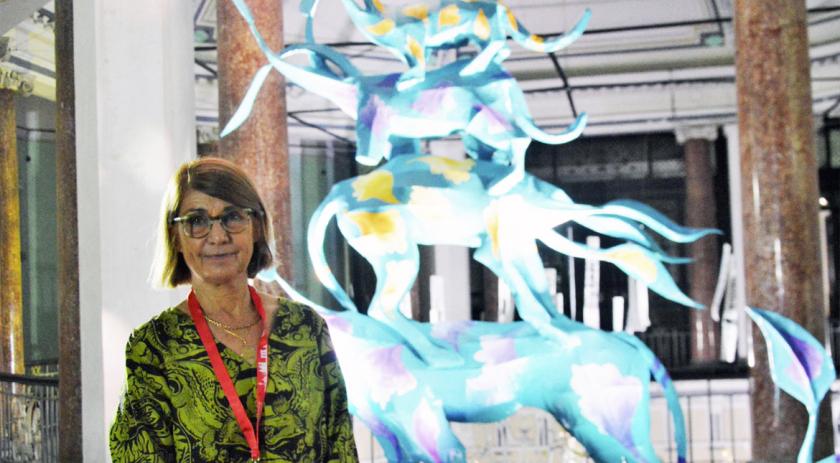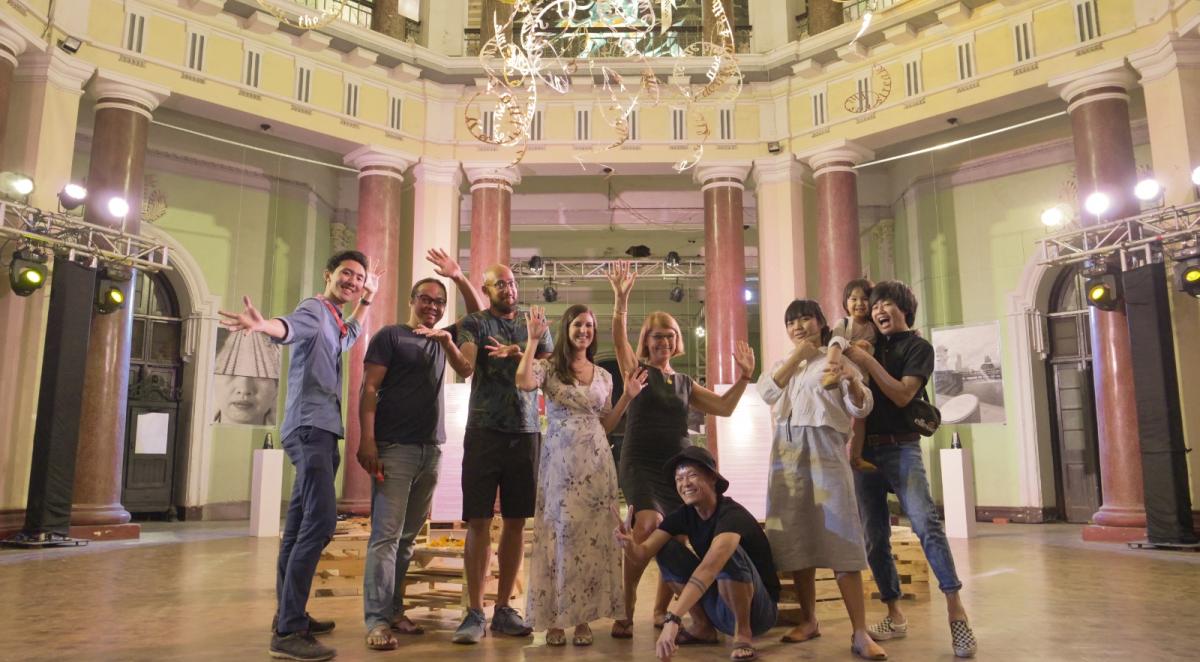
With its historical value and architectural glamour that resembles the Fu Xing Pavilion in the Summer Palace of Beijing, the Lim Chin Tsong Palace has graced Yangon’s skyline for almost a century.
When The Singapore Festival 2020 brought its culinary and cultural magic to Yangon – Lim Chin Tsong was organiser’s location of choice. The slogan this year was “Art Walk: The Time is Yours,” words that welcomed visitors to the new culture of Singapore in the ancient architecture of this intriguing palace.
The building hosted new artworks from eleven Singaporean and Myanmar artists. Some of the artworks were co-created, exploring the different elements of time – as they relate to Myanmar and Singapore.

Artists: Koh Tat Wee (for Urich Lau), Singapore, Marc Nair, Singapore (Standing), Nicola Anthony, UK, Singapore,
Marie-Pierre Mol (The Curator), France, Pang, Singapore, Zoncy, Myanmar, Dau Dai, Myanmar.
Simply called ‘“Time,” the exhibition was curated by Marie Pierre Mol, who helped organise the artists and arrange their work.
Metro sat down with Marie Pierre Mol to talk about the exhibition, and the challenge of matching the new with the old at Lim Chin Tsong Palace.

Can you tell me a bit about the exhibition?
When I was first asked to curate the exhibition at the Lim Chin Tsong Palace, I was excited and interested because I knew about this building. It’s full of history and memories.
The architecture is also quite unusual, and the man who built this place was not only a very rich man, but also an obvious art lover. He even invited artists from Europe, because he wanted to pay tributes to art. Another interesting connection with art is that the University of Culture used to be here. Now, we still have the state school of fine arts in this compound.
What are the challenges you faced when preparing the exhibition?
It was very challenging because the palace was already full of decorations and so, we had to bring in the art to compete with the building itself. It is interesting bringing contemporary art, which is very different from the art in the building.
Tell me about the concept of time in the exhibition?
My very first idea was about time, because of the history and the memories tied up in this building. I proposed working with both artists from Myanmar and Singapore, which seemed to fit with the gallery’s name, “Intersections”. So the idea was to create encounters between art forms between different artists and cultures, using art as the common language.
To have this kind of collaboration with artists was challenging too, because they are all very individualistic. But, I like this challenge. I have worked with different artists from Myanmar and Singapore for ten years. And I saw they could do something interesting for this exhibition, and it also helped that some of the artists knew each other. I hope it’s refreshing.
How are the artworks different, from each other?
The exhibition includes eleven artists. In the way of collaboration, they decided on the concept together. There is a connection with Singapore, because Bart and Tynn Lay Nwe studied in Singapore. I like these four artists working together, and it was good that the artists proposed the works themselves. I just tried to be respectful of the practices of the artists, and so I included four artworks and eight installations by the eleven artists.
Can you tell me about some of the challenges of putting this exhibition together?
Time. We never had enough time. It’s a challenge but it’s was a good challenge, because it helped us focus.
Another challenge, of course, was the building itself. We were not allowed to do everything that we wanted. I was very stubborn, though. From the beginning, we needed special authorisation to hang the sculptures – so that took time to organise. In the end we decided to hang the photographs from the main dome.
The Singapore Tourism Board was very supportive and respectful of the concept for the exhibition, so that helped. They were interested in collaboration, something addressing questions of the environment and sustainability. And artists had lots of freedom.

Do you like to tell more about the link with the palace and artists? How did they collaborate with students of fine arts?
It was very surprising to find out that Bart once attended sculpture classes here. The palace is the place these artists really loved. They all had these kinds of links, so they also wanted the building to look good.
We also arranged to have installation clocks with students of fine arts. We had a good meeting with U Moe Nyo. Singaporean artist Pang has been engaged in community works in Japan, so he has experience working with community groups. When he worked with the students, he liked to empower them to push their boundaries and create something new. Pang’s idea is very contemporary and conceptual. This is why they use Thanaka in different forms in incense sticks and flowers.
What do you want the exhibition to mean for visitors?
It’s what we do with our time. It is to think about what we are today, and why. If we appreciate the present time, then we also feel responsible for our future – not just to complain about it, but to appreciate and embrace it too.
We want to share with young people a sense of importance about the time we have a name. It’s like playing a game of cards, but the cards have images of the environment on them. We get the hand we are dealt, but that doesn’t mean we can’t change it. We should help to protect the environment in the present – hopefully this is what people value, here and now.
The festival is only on for two days. After that, where can people find your work?
I am talking with other partners who will be interested in showcasing the works again. We will recreate the works for Singapore people to enjoy as well. The video works are easy to showcase in Singapore. Nicola’s works are light and they can easily be sent to Singapore.
Photographs are also rather easy to carry. If there are any other partners who are interested in the work here, they can certainly contact me for another exhibition.
Are there any plans for an online archive?
We are working on an online catalogue for the exhibition. The works will be archived for sure, as it’s another way people can enjoy the art. But, it will not be the same feeling you get when you look at the art in the palace.














